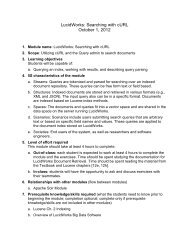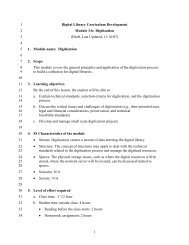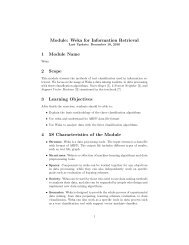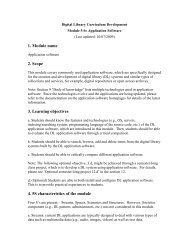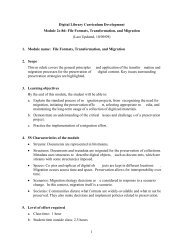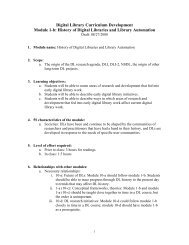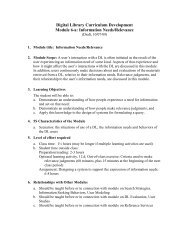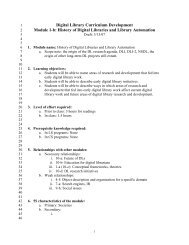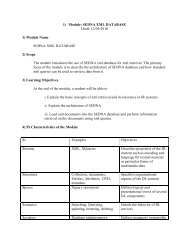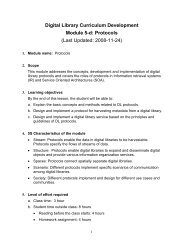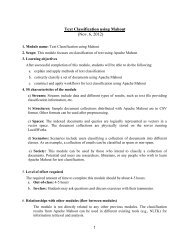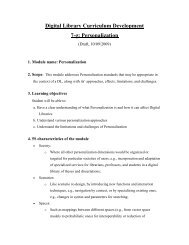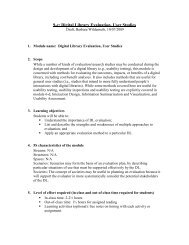Lemur (Draft last modified 12/08/2010) 1. Module name: Lemur 2 ...
Lemur (Draft last modified 12/08/2010) 1. Module name: Lemur 2 ...
Lemur (Draft last modified 12/08/2010) 1. Module name: Lemur 2 ...
You also want an ePaper? Increase the reach of your titles
YUMPU automatically turns print PDFs into web optimized ePapers that Google loves.
<strong>1.</strong> <strong>Module</strong> <strong>name</strong>: <strong>Lemur</strong><br />
<strong>Lemur</strong><br />
(<strong>Draft</strong> <strong>last</strong> <strong>modified</strong> <strong>12</strong>/<strong>08</strong>/<strong>2010</strong>)<br />
2. Scope<br />
This module addresses the basic concepts of the <strong>Lemur</strong> platform that is<br />
specifically designed to facilitate research in Language Modeling and information<br />
retrieval.<br />
3. Learning Objectives<br />
By the end of work on this module, students will be able to:<br />
a. Describe the basic workings of the <strong>Lemur</strong> Toolkit<br />
b. Use effectively the Indri search engine, a part of the <strong>Lemur</strong> Toolkit<br />
c. Do Language Modeling with the <strong>Lemur</strong> Toolkit<br />
d. Cluster documents using the <strong>Lemur</strong> Toolkit<br />
4. 5S Characteristics of the module<br />
a. Space: The concept of space for this module includes physical. The data<br />
collections and the <strong>Lemur</strong> application are stored in a physical space on<br />
servers (IBM cloud computers). <strong>Lemur</strong> creates an index which uses a<br />
vector space representation.<br />
b. Stream: Text documents and queries are inputs that lead to result sets as<br />
well as documents as the output of an IR system. These all are sequences<br />
of characters.<br />
c. Structure: Data collections are stored in a TREC or TRECWeb format<br />
structure.<br />
d. Scenario: These include where users/administrators and/or the system<br />
submit queries, cluster documents, do language modeling, and retrieve<br />
information.<br />
e. Society: End users of the system such as researchers, journalists,<br />
librarians, or developers who would like to use <strong>Lemur</strong> to search relevant<br />
data or to cluster documents.<br />
5. Level of effort required<br />
a. Class time: 2.5 hours<br />
b. Student time outside class:<br />
Preparation /reading: 2 hours<br />
6. Relationships with other modules:<br />
Related to module 7-a, which is indexing and searching
7. Prerequisite knowledge required:<br />
Basic Linux commands<br />
8. Introductory remedial instruction: None<br />
9. Body of Knowledge<br />
a. <strong>Lemur</strong> Toolkit Description<br />
Ø <strong>Lemur</strong> Toolkit Introduction<br />
The <strong>Lemur</strong> Toolkit has been created for the purpose of Language Modeling<br />
and Information Retrieval (IR). This toolkit is used for developing search<br />
engines, text analysis tools, browser toolbars, and data resources in the area of<br />
IR. <strong>Lemur</strong> supports the following features:<br />
o Indexing:<br />
§ English, Chinese, and Arabic text<br />
§ Word stemming<br />
§ Stop words<br />
§ Tokenization<br />
§ Passage and incremental indexing<br />
o Retrieval:<br />
§ Ad hoc retrieval (TF-IDF, Okapi, and InQuery)<br />
§<br />
§<br />
Passage and cross-lingual retrieval<br />
Language modeling<br />
• Query model updating<br />
• Two stage smoothing<br />
§ Relevance feedback<br />
§ Structured query language<br />
§ Wildcard term matching<br />
o Distributed IR:<br />
§ Query-based sampling<br />
§ Database based ranking (CORI)<br />
§ Results merging<br />
o Document clustering<br />
o Summarization<br />
o Simple text processing<br />
The programming language used to create <strong>Lemur</strong> is C++ and it comes along<br />
with the source files and a make file. The provided source code can be<br />
<strong>modified</strong> for the purpose of developing new libraries. It is compatible with<br />
various operating systems which include UNIX (Linux and Solaris) and<br />
Windows XP.<br />
The latest available version of the <strong>Lemur</strong> Toolkit is version 4.<strong>12</strong>.
Ø Indri Search Engine<br />
The Indri search engine is a subset of the <strong>Lemur</strong> Toolkit which is available for<br />
free for everyone. The query language that is used in Indri allows researchers<br />
to index data or structure documents without writing any code. Indri offers<br />
flexibility in terms of adaptation to various current applications. It also can be<br />
distributed across a cluster of nodes for high performance. The Indri API<br />
supports various programming and scripting languages like C++, Java, C#,<br />
and PHP. The latest available version of Indri is 2.<strong>12</strong>.<br />
b. Language Modeling and Information Retrieval Background<br />
Language Modeling is a probabilistic mechanism to generate a text. Language<br />
Modeling has been a subject of interest for researchers for the past few<br />
decades, especially statistical language modeling. The information retrieval<br />
community has proved that the language modeling approach is effective and<br />
provides an attractive framework for building IR systems.<br />
Ø Language Models for Text Retrieval<br />
The very basic techniques used in language modeling have been around for a<br />
very long time. For example in the Naïve Bayes text classification method, the<br />
unigram language model is estimated for each class, then combined with the<br />
class prior for classification. One problem with this approach, however, is that<br />
it assumes independence of words, which is unrealistic, and which language<br />
modeling overcomes.<br />
The method of using document language models to assign likelihood scores to<br />
queries has come to be known as the language modeling approach.<br />
Language models can be represented using finite automata, where each word<br />
can be represented as a state and the transitions between the different states<br />
are depicted. In language modeling each word is dependent on the words<br />
which occur before it. Assume a string contains four terms t1, t2, t3, and t4,<br />
occurring as “t1t2t3t4”. Its probability is determined using the chain rule, as<br />
shown using the equation below:<br />
Figure 1: Chain rule equation<br />
(Manning C. D., et al. (2009). Page 240. Chapter <strong>12</strong>. Language models for information<br />
retrieval. In Introduction to Information Retrieval. Cambridge University Press.)
The query likelihood language model constructs a language model for every<br />
document and calculates the probability of the document being generated by<br />
the query, i.e., P(q|d). The equation depicting the query likelihood language<br />
model is:<br />
Figure 2: Query Likelihood Language Model Equation<br />
(Manning C. D., et al. (2009). Page 245. Chapter <strong>12</strong>. Language models for information<br />
retrieval. In Introduction to Information Retrieval. Cambridge University Press.)<br />
where M d is the language model for the document, M c is the language model<br />
for the collection, d is a document, t is a term, q is a query and λ is a constant<br />
such that 0< λ
(ChengXiang Zhai, (2007). Notes on the KL-divergence retrieval formula and<br />
Dirichlet prior smoothing.)<br />
Where ps(w|d) is the smoothed probability of a word seen in the document, w<br />
is word, d is document, C is collection , αd is a coefficient controlling<br />
The Dirichlet prior determines the amount of smoothing based on a<br />
document’s length and performs better than fixed linear interpolation.<br />
Ø Jelinek-Mercer (JM) Smoothing<br />
JM smoothing is a traditional linear interpolation method. It focuses on<br />
mixing unigram maximum likelihood estimators with unigram background<br />
models. JM smoothing methods produces a movement of probability mass<br />
from seen terms in the documents.<br />
Figure 5: Retrieval Score of JM Smoothing Divergence<br />
(Advances in Multilingual and Multimodal Information Retrieval: 8th<br />
Workshop) <br />
Where it uses coefficient λ to control the influence, w is the word, d is the <br />
given document and C is collection of documents. <br />
Ø OKAPI<br />
OKAPI ranks documents based on their estimated relevance regarding the<br />
given query.<br />
Figure 6: Scoring function used by OKAPI<br />
Where f(qi,D) is qi's term frequency in the document D, | D | is the length of<br />
the document D in words, and avgdl is the average document length in the text<br />
collection from which documents are drawn. k 1 and b are free parameters,<br />
usually chosen as k 1 = 2.0 and b = 0.75. IDF(qi) is the IDF (inverse document<br />
frequency) weight of the query term qi.<br />
Ø Relevance Feedback<br />
Relevance feedback (RF) involves the user in the retrieval process so as to<br />
improve the final result set. In particular, the user gives feedback on the
elevance of documents in an initial set of results. There are different methods<br />
such as probabilistic relevance feedback and the Rocchio algorithm relevance<br />
feedback.<br />
Ø Wildcard queries<br />
A wildcard query is a term that contains “*”. It is used when the user<br />
is uncertain of a query term or the user seeks documents containing variants<br />
of a particular term.<br />
Ø Galago<br />
Every search engine supports some kind of query language, but Galago takes the<br />
query language concept a bit further than most. In Galago, the query language<br />
defines the ranking function. In other systems you might consider changing the<br />
ranking code to get a desired result, but in Galago you usually just change the<br />
query.<br />
Ø <strong>Lemur</strong> Query Toolbar<br />
The <strong>Lemur</strong> Query Log Toolbar is a FireFox Add-On and alternatively, a plugin<br />
for IE, that captures user browsing behavior specifically when loading web pages<br />
and generating search engine requests. A set of configuration options enable<br />
researchers and users to specify toolbar behavior.<br />
Ø XML Retrieval<br />
XML Retrieval, or XML Information Retrieval, supports documents structured<br />
with XML (eXtensible Markup Language). As such it is used for estimating the<br />
relevance of XML documents.<br />
Ø Cross-language Information Retrieval<br />
Cross-language information retrieval (CLIR) is a subfield of information retrieval<br />
dealing with retrieving information written in a language different from the<br />
language of the user's query. For example, a user may pose their query in English<br />
but retrieve relevant documents written in French.<br />
Ø Pseudo Relevance Feedback<br />
Pseudo relevance feedback, also known as blind relevance feedback, provides a<br />
method for automatic local analysis. It automates the manual part of relevance<br />
feedback, so that the user gets improved retrieval performance without an<br />
extended interaction. The method is to do normal retrieval to find an initial set of<br />
most relevant documents, add their terms to the query, and then repeat this<br />
process and finally return what hopefully are the most relevant documents.<br />
Ø Krovetz Stemmer<br />
The Krovetz Stemmer was developed by Bob Krovetz, at the University of<br />
Massachusetts, in 1993. It is quite a 'light' stemmer, as it makes use of inflectional<br />
linguistic morphology.
Ø Porter Stemmer<br />
The Porter stemming algorithm (or ‘Porter stemmer’) is a process for removing<br />
the commoner morphological and inflexional endings from words in English. Its<br />
main use is as part of a term normalization process that is usually done when<br />
setting up Information Retrieval systems.<br />
Ø Using the <strong>Lemur</strong> Toolkit:<br />
A. Introduction<br />
B. Indexing<br />
i. The <strong>Lemur</strong> Toolkit has been installed, compiled, and is ready to<br />
use on the cloud instance. Apart from the basic utilities of <strong>Lemur</strong>,<br />
the clustering plugin also has been installed. <strong>Lemur</strong> has a wide<br />
variety of plugins one can install. You can look up<br />
http://sourceforge.net/apps/trac/lemur/wiki/Compiling%20and%20<br />
Installing for details about the other available plugins.<br />
The first step before you start searching is to index all the data you<br />
have. Explained below are the data formats supported for your data<br />
and the different types of parameters you can set before you begin<br />
indexing.<br />
i. Data Format<br />
The <strong>Lemur</strong> Toolkit accepts data in two formats -TRECTEXT and<br />
TRECWEB format. Following are examples, one for each of these<br />
formats.<br />
TRECTEXT Format<br />
<br />
1<br />
<br />
document content<br />
<br />
<br />
TRECWEB Format<br />
<br />
...<br />
<br />
... e.g. URL<br />
and other metadata information
... HTML content<br />
<br />
ii. Parameters<br />
There are a number of parameters you can set before you begin<br />
indexing, like the memory, the type of stemmer to be used, the<br />
location of the corpus on your file system, etc. These are depicted in<br />
the example below:<br />
<br />
200m<br />
/path/to/outputIndex-v4.11<br />
<br />
docno<br />
docno<br />
<br />
<br />
krovetz<br />
<br />
<br />
/path/to/collection1/<br />
trectext<br />
<br />
<br />
/path/to/collection2/<br />
trecweb<br />
<br />
title<br />
datetrueDateFieldAnnotator<br />
<br />
The purposes of the parameters are as follows:<br />
Memory parameter - defines a rough limit for RAM memory<br />
consumption by the indexer.<br />
Metadata - the forward tag helps define fast forward retrieval and<br />
the backward tag helps define fast backward retrieval.
Stemmer - The <strong>Lemur</strong> toolkit provides two types of stemmers:<br />
Krovtz and Porter.<br />
Field - The columns mentioned in the field tags can be searched<br />
using Indri.<br />
Corpus - Indicates the location of the corpus in your filesystem.<br />
iii. Indexing Command<br />
After the data is in its correct format and the parameters have been<br />
set, indexing can be done using the following command:<br />
lemur-4.11/app/obj/IndriBuildIndex parameter_file<br />
C. Retrieval<br />
Similar to setting parameters for indexing, one must set parameters<br />
for batches of queries too before retrieval.<br />
i. Query parameter file<br />
Given below is an example of how the query can be specified<br />
between the text tags.<br />
<br />
<br />
indri<br />
751<br />
<br />
#combine( popular scrabble players )<br />
<br />
<br />
<br />
indri<br />
752<br />
<br />
#combine( dam removal environmental impact )<br />
<br />
<br />
<br />
Where indicates QueryID, #combine indicates OR<br />
operation on the specified query.
ii. Retrieval Command<br />
The command for retrieval is:<br />
lemur-4.11/app/obj/IndriRunQuery query_parameter_file -<br />
count=1000 -index=/path/to/index -trecFormat=true > result_file<br />
-count is used to specify the number of output files to be displayed as<br />
result of the query which is executed by the user.<br />
-index specifies the location of the index in the filesystem<br />
-trecFormat = true specifies that the file is in TREC format<br />
D. Evaluation<br />
E. Clustering<br />
The <strong>Lemur</strong> Toolkit also allows you to perform evaluation of your<br />
results using the following command:<br />
trec_eval -q QREL_file Retrieval_Results > eval_output<br />
where the QREL_file contains the ideal results and<br />
Retrieval_Results contains the results returned by the <strong>Lemur</strong> Toolkit.<br />
In the beginning of this section it was mentioned that on the cloud<br />
instance apart from the basic lemur Toolkit, the clustering plugin has<br />
also been installed. Here is a brief description of how to perform<br />
clustering using the <strong>Lemur</strong> Toolkit.<br />
Ø <strong>Lemur</strong> Clustering<br />
o Overview<br />
Document clustering is the action of assembling documents in a same<br />
group. <strong>Lemur</strong> supports different types of clustering algorithms such as<br />
probabilistic latent semantic analysis (PLSA), agglomerative hierarchical,<br />
K-means, and bisecting K-means. With the exception of Probabilistic<br />
Latent Semantic Analysis (PLSA), all use cosine similarity in the vector<br />
space model as their metric.<br />
The LEMUR clustering supports two principal APIs, the Cluster API, that<br />
defines the clusters themselves, and the ClusterDB API, that defines how<br />
clusters are persistently stored.<br />
o Applications<br />
§ Cluster<br />
Performs the basic online clustering task. The parameters accepted<br />
by Cluster are:<br />
• Index -- the index to use. Default is none.
§<br />
§<br />
• clusterIndex -- the <strong>name</strong> of the cluster database index to<br />
use. Default is none.<br />
• clusterdb_type -- One of flatfile (simple cluster database) or<br />
keyfile (btree based).<br />
• clusterType -- Type of cluster to use, either agglomerative<br />
or centroid. Centroid is agglomerative using mean which<br />
trades memory use for speed of clustering. Default is<br />
centroid.<br />
• simType -- The similarity metric to use. Default is cosine<br />
similarity (COS), which is the only implemented method.<br />
• docMode -- The scoring method to use for the<br />
agglomerative cluster type. The default is max (maximum).<br />
The choices are:<br />
• max -- Maximum score over documents in a cluster.<br />
• mean -- Mean score over documents in a cluster. This is<br />
identical to the centroid cluster type.<br />
• avg -- Average score over documents in a cluster.<br />
• min -- Minimum score over documents in a cluster.<br />
• threshold -- Minimum score for adding a document to an<br />
existing cluster. Default is 0.25.<br />
Offline Cluster<br />
Performs the basic offline clustering. The parameters accepted by<br />
OfflineCluster are:<br />
• index -- the index to use. Default is none.<br />
• clusterType -- Type of cluster to use, either agglomerative<br />
or centroid. Centroid is agglomerative using mean which<br />
trades memory use for speed of clustering. Default is<br />
centroid.<br />
• simType -- The similarity metric to use. Default is cosine<br />
similarity (COS), which is the only implemented method.<br />
• docMode – The scoring method to be used for the<br />
agglomerative cluster type. The default is max (maximum).<br />
The choices are:<br />
o max -- Maximum score over documents in a cluster.<br />
o mean -- Mean score over documents in a cluster.<br />
This is identical to the centroid cluster type.<br />
o avg -- Average score over documents in a cluster.<br />
o min -- Minimum score over documents in a cluster.<br />
• numParts -- Number of partitions to split into. Default is 2.<br />
• maxIters -- Maximum number of iterations for k-means.<br />
Default is 100.<br />
• bkIters -- Number of k-means iterations for bisecting k-<br />
means. Default is 5.<br />
PLSA
Performs Probabilistic Latent Semantic Analysis (PLSA) on a<br />
document collection to build three probability tables: P(z), P(d|z),<br />
and P(w|z).<br />
The parameters accepted by PLSA are:<br />
• index -- the index to use. Default is none.<br />
• numCats -- the number of latent variables (categories) to<br />
use. Default is 20.<br />
• beta -- The value of beta for Tempered EM (TEM). Default<br />
is <strong>1.</strong><br />
• betaMin -- The minimum value for beta; TEM iterations<br />
stop when beta falls below this value. Default is 0.6.<br />
• eta -- Multiplier to scale beta before beginning a new set of<br />
TEM iterations. Must be less than <strong>1.</strong> Default is 0.92.<br />
• annealcue -- Minimum allowed difference between<br />
likelihood in consecutive iterations. If the difference is less<br />
than this, beta is updated. Default is 0.<br />
• numIters -- Maximum number of iterations to perform.<br />
Default is 100.<br />
• numRestarts -- Number of times to recompute with<br />
different random seeds. Default is <strong>1.</strong><br />
• testPercentage -- Percentage of events (d,w) to hold out for<br />
validation.<br />
• doTrain -- whether to construct the probability tables or<br />
read them in. Default is true.<br />
o Clustering API<br />
§ Cluster<br />
Provides an abstraction over a collection of clusters.<br />
§ ClusterDB<br />
Provides for interactions with persistent collections of cluster<br />
objects.<br />
§ Similarity Method<br />
SimilarityMethod is an abstraction over comparing two ClusterRep<br />
(vector space representation) cluster objects. To add a new<br />
SimilarityMethod, one needs to do the following:<br />
<strong>1.</strong> In ClusterParam.hpp add a symbol for the new method in<br />
the simTypes enum.<br />
2. In ClusterParam.hpp add an else if to test the<br />
simTypeString for equality with the new method type<br />
parameter.<br />
3. In SimFactory.hpp add an include statement for the new<br />
method's header file.<br />
4. In SimFactory.hpp add a case for the new method symbol<br />
to makeSim that makes an instance of the new method.
o Instructions:<br />
a. Indexing<br />
5. Recompile your <strong>Lemur</strong> library.<br />
(http://www.cs.cmu.edu/~lemur/3.1/cluster.html#applicatio<br />
n)<br />
Index the data to be clustered as described in the previous sections.<br />
b. Clustering Parameters<br />
The parameters for clustering must be specified as follows:<br />
<br />
/path/to/your/index/file<br />
centroid<br />
max<br />
<br />
The cluster type tag specifies the type of clustering to be performed.<br />
c. Command for clustering<br />
The command for clustering using the <strong>Lemur</strong> Toolkit is:<br />
Cluster centroid_cluster.OfflineCluster.xml ><br />
centroid_cluster_<strong>last</strong>.log<br />
where the centroid_cluster.OfflineCluster.xml file contains the<br />
parameters described in the previous section and<br />
centroid_cluster_<strong>last</strong>.log is the file to which the output is written.<br />
Ø Relationship to Chapters from the textbook<br />
<strong>Lemur</strong> uses some of the concepts described in the IR textbook Chapters 6, 7<br />
and <strong>12</strong> like:<br />
o Word stemming<br />
o Stop words<br />
o Tokenization<br />
o Ad hoc retrieval (TFIDF, Okapi, and InQuery)<br />
o Language modeling<br />
o Relevance feedback<br />
o Structured query language<br />
o Wildcard term matching<br />
o Query-based sampling<br />
o Document clustering
o Simple Text processing<br />
10. Resources<br />
Required reading for students<br />
• Manning C. D., et al. (2009). Chapter <strong>12</strong>. Language models for information<br />
retrieval. In Introduction to Information Retrieval. Cambridge University<br />
Press.<br />
• Manning C. D., et al. (2009). Chapter 9. Relevance feedback & query<br />
expansion. In Introduction to Information Retrieval. Cambridge University<br />
Press.<br />
• Manning C. D., et al. (2009). Chapter 1<strong>1.</strong> Probabilistic information retrieval.<br />
In Introduction to Information Retrieval. Cambridge University Press.<br />
• Manning C. D., et al. (2009). Chapter 16. Flat clustering. In Introduction to<br />
Information Retrieval. Cambridge University Press.<br />
• Manning C. D., et al. (2009). Chapter 17. Hierarchical clustering. In<br />
Introduction to Information Retrieval. Cambridge University Press.<br />
Recommended reading for students<br />
• <strong>Lemur</strong> web page http://www.lemurproject.org/<br />
• <strong>Lemur</strong> wiki page http://sourceforge.net/apps/trac/lemur/wiki<br />
• <strong>Lemur</strong> Toolkit Documentation<br />
http://www.lemurproject.org/doxygen/lemur/html/index.html<br />
1<strong>1.</strong> Concept map
<strong>12</strong>. Exercises/Learning activities<br />
Figure 5: <strong>Lemur</strong> concept map<br />
TRECEVAL is a program to evaluate TREC results using the standard, NIST <br />
evaluation procedures. The dataset used for solving the exercise questions given <br />
below is a part of the TRECEVAL dataset from CD-‐<strong>1.</strong> It contains a set of articles
from various technical journals. <br />
Mr. David is a data analyst, whose primary job is to keep track of the content<br />
being published by the technical magazines and to report any interesting<br />
observations he finds. Mr. Davis is currently using the <strong>Lemur</strong> Toolkit for his<br />
work.<br />
<strong>1.</strong> Mr. David would like to study the Microsoft vs. Apple trend and see<br />
which of these two companies has more coverage in the magazines. But<br />
<strong>Lemur</strong> offers multiple ways to analyze the data present:-<br />
i. Simple TF-IDF<br />
ii. TF-IDF with feedback retrieval<br />
iii. Simple Okapi<br />
iv. Language Modeling with various smoothing methods like JM<br />
Smoothing and Dirichlet Smoothing<br />
Your duty is to run each of these methods in <strong>Lemur</strong>, which will help him<br />
in his study.<br />
(HINT:<br />
Step 1: Index the data provided in the collections folder.<br />
Step 2: Run each of the methods from i. to iv., with the query term as<br />
‘Microsoft’.<br />
Step 3: Repeat Step 2, with query term as ‘Apple’.<br />
Step 4: Compare results in Steps 2 and 3.)<br />
2. Mr. David wants to study all the articles published by PC Magazine.<br />
Use the Language Modeling feature available in <strong>Lemur</strong> to help him<br />
retrieve all the articles published by PC Magazine.<br />
3. Matzkin is considered one of the most popular technical writers of the<br />
current era. Help Mr. David to locate the articles written by Matzkin.<br />
4. Your final task if to help Mr. David to cluster all the articles available<br />
from the TREC EVAL data set provided to you. Use the centroid<br />
clustering method.<br />
13. Evaluation of learning achievement<br />
At the end of this module, students must understand the working of the <strong>Lemur</strong><br />
Toolkit. They must be able to formulate queries, execute searches, cluster<br />
documents, and evaluate the results.<br />
14. Glossary<br />
• Collection: A group of items, often documents.<br />
• Feature: Information extracted from an object and used during query<br />
processing.
• Index: A data structure built for the documents to speed up searching.<br />
• Information Retrieval: Part of Computer Science that studies retrieval of<br />
information (not data) from a collection of written documents.<br />
• Metadata: Attributes of a data or a document.<br />
• Query: The expression of the user information need in the input language<br />
provided by the information system.<br />
• Relevance feedback: An interactive process of obtaining information from the<br />
user about the relevance and the non-relevance of retrieved documents.<br />
• Language Model: A statistical language model assigns a probability to a<br />
sequence of m words by means of a probability distribution. <br />
• Cluster: a grouping of a number of similar things<br />
15. Contributors<br />
a. Iccha Sethi<br />
b. Serdar Aslan<br />
c. Dr. Edward Fox<br />
Information Storage and Retrieval CS 5604<br />
Virginia Polytechnic Institute and State University<br />
Blacksburg, VA 24061 USA



